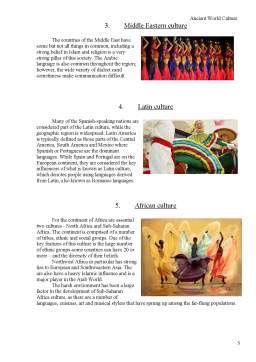Cuprins
- Chapter 1-It’s a Cultural World
- Modern Culture 4
- The Origin of Culture 6
- The Evolution of Culture 8
- Chapter 2-It’s a Ancient Civilized World
- The Ancient Mesopotamia 11
- The Ancient Persia 13
- The Ancient Egypt 14
- The Ancient Greece 17
- The Vikings 20
- The Ancient Africa 22
- The Maya 23
- The Aztec 24
- Chapter 3-It’s a Legendary World
- What Is a Legend- 26
- How Was the Legends Created- 26
- Ancient World Legends about Creation the World 27
- Conclusion 33
- Bibliography 34
Extras din proiect
Objectives:
- To define the word “Culture”
- To define the word ”Legend”
- To classify the Modern Culture
- To explain the Origin of Culture
- To show the Evolution of Culture
- To review the Ancient Culture
- To identify the causal relationship between Ancient Culture and nowadays life
- To describe Legends about the World Creation
- To express my own point of view
‡ Chapter 1 — It’s a Cultural World.
Modern Culture
What does the word “culture” mean?
Culture is the characteristics of a particular group of people, defined by everything from language, religion, cuisine, social habits, music and arts. Today, in every country which is largely populated by immigrants, the culture is influenced by the many groups of people that now make up the country.
Every nation has it’s own culture and traditions, which also has been influenced a lot by the geographic position. By localization, culture can be divided in five groups:
1. Western culture
The term Western culture has come to define the culture of European countries as well as those such as the United States that have been heavily influenced by European immigration. Western culture has its roots in the Classical Period of the Greco-Roman era and the rise of Christianity in the 14th century.
Other drivers of the Western culture include Latin, Celtic, Germanic and Hellenic ethnic and linguistic groups. Today, the influences of Western culture can be seen in almost every country in the world.
2. Eastern Culture
Eastern culture generally refers to the societal norms of countries in Far East Asia (including China, Japan, Vietnam, North Korea and South Korea) and the Indian subcontinent. Like the West, Eastern culture was heavily influenced by religion during it’s early development. In general, in Eastern culture there is less of a distinction between secular society and religious philosophy than there is in the West.
3. Middle Eastern culture
The countries of the Middle East have some but not all things in common, including a strong belief in Islam and religion is a very strong pillar of this society. The Arabic language is also common throughout the region; however, the wide variety of dialect cand sometimesc make communication difficult
4. Latin culture
Many of the Spanish-speaking nations are considered part of the Latin culture, while the geographic region is widespread. Latin America is typically defined as those parts of the Central America, South America and Mexico where Spanish or Portuguese are the dominant languages. While Spain and Portugal are on the European continent, they are considered the key influencers of what is known as Latin culture, which denotes people using languages derived from Latin, also known as Romance languages.
5. African culture
For the continent of Africa are essential two cultures - North Africa and Sub-Saharan Africa. The continent is comprised of a number of tribes, ethnic and social groups. One of the key features of this culture is the large number of ethnic groups-some countries can have 20 or more – and the diversity of their beliefs.
Northwest Africa in particular has strong ties to European and Southweastern Asia. The are also have a heavy Islamic influence and is a major player in the Arab World.
The harsh environment has been a large factor in the development of Sub-Saharan Africa culture, as there are a number of languages, cuisines, art and musical stylers that have sprung up among the far-flung populations.
The Origin of Culture
Spoken language couldn’t suddenly appear without the facilities to communicate symbolically already established in human neurology. Today, if human children are not taught language by puberty, language can not be learned. If early humans didn’t muddle through communication as adults, who taught the children- Yet evidence of culture, often assumed to be evidence of language, didn’t appear slowly, but suddenly. There’s no paradox to be found here if the facilities for symbol and metaphor were already present in another physical, gestural, touch form and transferred over to spoken language.
Bibliografie
“The Origin of Culture” by Thomas Dietrich
“ The Viking Revival” By Professor Andrew Wawn
http://www.mrdowling.com/609-test.htm
http://ancienthistory.pppst.com/index.html
http://en.wikipedia.org/wiki/Aztec#Aztec_culture
http://trinityweblog.org/marwh1213/2011/10/12/mesopotamian-music-and-dances/
http://www.bookrags.com/history/ancient-mesopotamia-lifestyle-and-recreation/sub7.html
http://www.amazon.com/Writing-Ancient-Persia-Classical-Essays/dp/071563917
http://www.jstor.org/discover/10.2307/3210912?uid=3738528&uid=2&uid=4&sid=21102230480901
http://www.infoplease.com/encyclopedia/history/babylon-ancient-city-mesopotamia.html
http://www.antiessays.com/free-essays/172233.html
http://www.preservearticles.com/201107048767/1321-words-short-essay-on-the-culture.html
http://en.wikipedia.org/wiki/Legend
http://en.wikipedia.org/wiki/List_of_creation_myths
http://www.desy.de/gna/interpedia/greek_myth/creation.html
http://ancienthistory.about.com/od/creationmyths/a/11083199Norse.htm
http://www.gly.uga.edu/railsback/CS/CSIndex.html
http://www.gly.uga.edu/railsback/CS/CSMarduk.html
Preview document
Conținut arhivă zip
- Ancient World Cultures.docx
















































